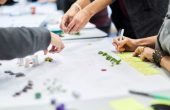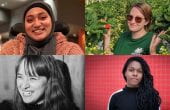Anyone familiar with this blog will know that I am passionate about using the power of fashion to tackle social, environmental or political issues.
At LCF we like to use fashion to reach out to the wider community and provide opportunities to those in most need.
That’s why we created Making for Change (MFC). Part of LCF’s Fashion Education in Prisons programme, Making for Change is a fashion training and manufacturing unit at HMP Downview which provides skills and meaningful employment for female offenders.
It is well known that prisoners face difficulty finding living wage jobs after incarceration. With a lack of basic job skills many female prisoners are unemployed a few months after release, and unsurprisingly 45% of women in the UK are re-convicted within a year of release.
This is a significant social and economic issue and we believe it’s important to use fashion to help change this. Thankfully, we are not completely alone in this pursuit. Another institution which continues to inspire our work on rehabilitation is San Patrignano.

Founded in 1978 by Vincenzo Muccioli, on the hills of Rimini, San Patrignano is a community for young people who have suffered from drug addiction. It is a radical alternative to prison that offers young people a holistic recovery.
Our Director of Social Responsibility, Claire Swift visited the community in back in July to learn more about their vision and methods, which can then inspire our own work. Claire described how the community works:
“San Patrignano gives young people the ability to address their issues through working, health and wellbeing. The focus is not so much on the drugs as the issue, instead it’s a totally holistic view that asks what the issue was that led you to drug abuse in the first place.”
Some people are referred to the community by the courts, others by their families and some people refer themselves, as it’s very well known within Italy. An assessment is undertaken to determine if the community can help the young person, and – if accepted – they will then be welcomed into the community for a minimum of 2 years.

Although very different from a normal prison, there are still certain rules and regulations that people have to follow whilst at San Patrignano.
“You have no connection with the outside world for the first year. You can’t connect with your family, there are no phones, no internet, so in that sense it is very similar to prison. They will be allowed visits after the first year upon negotiation.
“Men and women also don’t work or live together. The only time they come together is in the dining hall when they eat. When I visited, we went in to eat and everyone stands, there’s no church or religious denomination but everyone has a silent prayer – it’s very respectful. When people are giving out food you don’t ask for more than you’re going to eat. It’s a subtle, underlying rule about greed.”
However these rules are not written down anywhere, they’re given to the new participant by the mentors – people who have been a part of the community for a few of years and are assigned to new members to support them.
Everyone is free to come and go at San Patrignano (you can just walk out), however when you step into the community you have to go to work. Every young person is assigned to a different skill and they’re there to learn that skill and become a part of that community. Claire explains:
“It is really all about learning through the discipline of craft. It could be wine making, handmade wall paper, furniture making, organic food growing, retail or weaving. There are many different departments, but all are very high end craft.
“It’s about a 360 degree view of the person and that person’s role and accountability within the community – and they do it by the way of the craft skills they’re developing.”

Each member of the community is encouraged to own their individual process of rehabilitation:
“They might go there and say I’m not going to do any work and they’ll have a really tough time as everyone gets up and goes to work in the morning. Everything is about relationship and building communities within the community. There’s the weaving community, the wallpaper community. What are you going to do if you decide you’re not going to work, who do you belong to?”
Whether weaving or wall paper making, each business is separate and functions in its own right, but all income that each business earns feeds into the whole community. This allows San Patrignano to be free of cost to all participants.
“It’s a totally sustainable community, firstly because they grow their own produce on site to provide food, and secondly because all of the businesses work with external clients and bring in an income.”
Claire was particularly interested in the weaving community, which has been supported by the Zegna Foundation, and how as a college we might connect with them.
In the weaving community, women learn to produce fine fabrics using harness looms. The fabric patterns are donated by leading designers, then the weaving itself is undertaken by the artisans of San Patrignano. Their clients include the likes of Victoria Beckham, Chanel and Salvatore Ferragamo.

Claire saw an opportunity to collaborate with our Making for Change unit and we are currently working on a project which will see our BA Menswear students work with fabrics specially created by the weavers in the community in San Patrignano to create designs for accessory pieces. Prototypes of selected student’s design ideas will then be made by the participants at Making for Change, HMP Downview.
Tom said: “Bethany and myself have been through the archives and found some great weaves and ideas for finishing, and I am sure there will be some great fabrics for us to work with.
“l am very honoured to have the opportunity to be involved in this as it is very special, both creatively and ethically. I think this will have a very positive affect on the students and show them what creativity can do as a part of positive change.”
I plan to follow up with Tom and Bethany to hear about their visit after Christmas, but am excited to see how our relationship with San Patrignano grows. Claire explains how we plan to work together further:
“What we’re trying to work on now with Making for Change is we are trying to develop routes into industry so once the women leave the prison they have employment. It’s something San Patrignano also want to work on, because at the moment once participants leave, they have no way of tracking them or supporting them into getting a job.
“Artisan craft is a dyeing skill and there are very few weaving jobs for instance. It’s such a specialist skill that there are not many employment opportunities. So, we are thinking about developing their skills that might mean that they could go to work in fashion studios – possibly a design studio or the manufacturing industry. We are trying to build in programs that start to bridge that gap.”
It is really inspiring to see other institutions trying to use fashion to tackle important social issues and help change lives. And, by working together, we can achieve even more than we are able to alone.
To find out more:
http://www.sanpatrignano.com
http://www.bethany-williams.com/
http://www.arts.ac.uk/fashion/about/better-lives/




